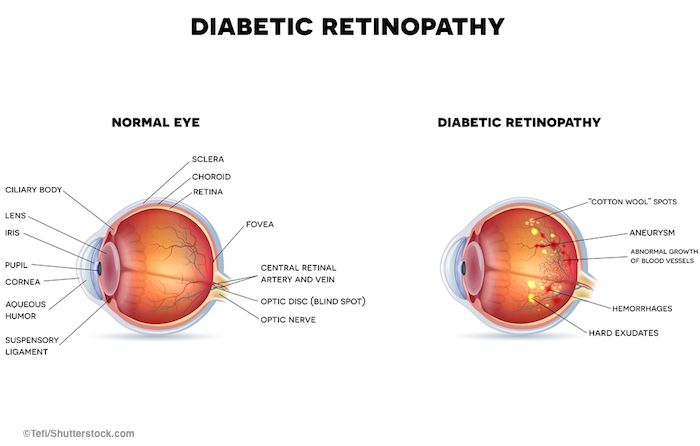Obesity + diabetic retinopathy: Korean study explores inverse association

A Korean study identified an inverse association between vision-threatening diabetic retinopathy and body fat in patients with type 2 diabetes.
Previous studies have reached conflicting results regarding the relationship between obesity and diabetic retinopathy (DR). A recent study found that obese Korean patients with diabetes might be less likely to develop vision-threatening DR.
In addition, the authors uncovered a gender difference, i.e., in women total body fat was associated with a lower presence of DR.
Establishing an association between DR and diabetes is important because vision-threatening complications have been observed to develop in up to 10% of this patient population, the investigators noted.
The authors commented, “Although previous epidemiologic studies have demonstrated that poor glycemic control, hypertension, dyslipidemia, and a longer duration of diabetes increase the risk of DR, the known effects of controlling glucose and blood pressure are limited in reducing the risk of DR. Thus, other pathogenic or risk factors are important in understanding the development or progression of DR.”
In the current study, the authors, led by In Cheol Hwang of Gachon University, conducted a nationwide survey to evaluate the association between body mass index (BMI), waist circumference, and body fat with DR. All patients were Korean and had type 2 diabetes.
The study data were obtained from the Korean Health and Nutrition Examination Survey 2008-2010, a nationwide survey that is conducted periodically by the Korean Ministry of Health and Welfare. A total of 1,130 patients with diabetes were identified who had undergone ophthalmic examination. A total of 887 patients (men, 48.6%) ultimately were included; the rest were excluded because of ungradable fundus images.
RELATED: How does diabetic retinopathy influence cataract surgery?
Survey findings
The median patient age was 64 years (range, 22-93 years). DR developed in 185 (20.9%) of these patients; 130 (24.7%) had mild to moderate DR, and 55 (6.2%) had vision-threatening DR; 702 (79.1%) patients had no DR. The authors reported their findings in Eye (2019; https://www.nature.com/articles/s41433-019-0352-z).
Multivariate-adjusted analyses indicated that a higher BMI (p = 0.001), larger waist circumference (p = 0.047), and higher total body fat (p < 0.001) were associated significantly with a lower risk of vision-threatening DR, the investigators reported. Interestingly, those factors did not confer any protective effects in patients with mild/moderate DR in either continuous or categorical analyses.
This finding about the effect of a higher BMI agrees with other recent studies conducted in Asian populations.
RELATED: Deep learning predicts OCT measures of diabetic macular thickening
For example, the Singapore Epidemiology of Eye Diseases cohort studies reported an inverse association of BMI with both the presence and severity of DR, and the Shanghai Diabetes Registry Database study also showed that overweight patients with type 2 diabetes had a lower risk of DR than subjects whose weight was normal.
However, this effect was not found in studies of Western patients and may indicate the effect of different ethnic groups or study methods.
When stratified by sex, the current multivariate analyses showed no significant associations between DR and BMI or waist circumference in patients with type 2 diabetes.
However, the investigators reported that in female patients, the total body fat was associated significantly with the presence of DR (p = 0.009).
After they adjusted for BMI and waist circumference, a significance inverse relationship was observed between total body fat and the severity of the DR in women (p for trend = 0.004) but not in men (p for trend = 0.126).
They commented, “Sex-stratified analyses revealed that total body fat was significantly associated with lower prevalence of DR in women with type 2 diabetes. Our results suggest that a high fat composition might play a protective role in the development and progression of DR in women with type 2 diabetes.”
RELATED: Image-reading accuracy Increases with deep-learning DR algorithms
The authors speculated about a possible reason for this finding.
“The sex-specific effect of body fat on DR might be related to intrinsic hormonal responses or body fat distribution. Some studies have suggested that estrogen might play an important role in body fat distribution in women, who have more peripheral and lower body fat distribution, than in men, who typically have more truncal and upper body fat deposition.”
The investigators also speculated that because men have a “narrow range of total body fat,” this may explain the lack of association between body fat and DR.
Based on their finding, they concluded: “In Korean patients with type 2 diabetes, obese patients might be less likely to have vision-threatening DR. Total body fat in women appears to be inversely and independently associated with DR prevalence and progression.”
RELATED: Four ways to discuss diabetic treatment with patients
Disclosures:
In Cheol Hwang MD, MPH, PhD
Dr. Hwang is affiliated with the Department of Family Medicine, Gil Medical Center, Gachon University College of Medicine, Incheon, Republic of Korea.
The authors who were from Gil Medical Center, Gachon University College of Medicine, Incheon, Republic of Korea, and Kangbuk Samsung Hospital, Sungkyunkwan University School of Medicine, Seoul, Republic of Korea, reported no financial interests in any aspect of this report.
Newsletter
Keep your retina practice on the forefront—subscribe for expert analysis and emerging trends in retinal disease management.